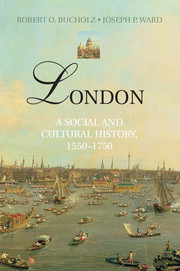Book contents
- Frontmatter
- Contents
- List of Illustrations and Maps
- List of Abbreviations and Conventions
- Acknowledgments
- Maps
- Introduction: London's Importance
- 1 London in 1550
- 2 The Socioeconomic Base
- 3 Royal and Civic London
- 4 Fine and Performed Arts
- 5 The Public Sphere and Popular Culture
- 6 The People on the Margins
- 7 Riot and Rebellion
- 8 Plague and Fire
- Conclusion: London in 1750
- Notes
- Further Reading
- Index
- Plate Section
2 - The Socioeconomic Base
Published online by Cambridge University Press: 05 November 2012
- Frontmatter
- Contents
- List of Illustrations and Maps
- List of Abbreviations and Conventions
- Acknowledgments
- Maps
- Introduction: London's Importance
- 1 London in 1550
- 2 The Socioeconomic Base
- 3 Royal and Civic London
- 4 Fine and Performed Arts
- 5 The Public Sphere and Popular Culture
- 6 The People on the Margins
- 7 Riot and Rebellion
- 8 Plague and Fire
- Conclusion: London in 1750
- Notes
- Further Reading
- Index
- Plate Section
Summary
The Demographic Reality
The most important fact about early modern London, the one about which contemporaries and historians are universally agreed, is that it was growing – from about 120,000 souls in 1550 to 675,000 in 1750 – and growing faster than England as a whole. Why did London's population grow faster than the rest of the country's? London's demographic expansion could not have been caused by the reproduction of its own population, because early modern London's death rate was higher than its birth rate: out of every 1,000 Londoners, 35 would be born each year, but 40 would die. The reasons for London's deadly demographic profile should be obvious from our tour of the city in 1550: the population density in London's core was 100 persons per acre in 1550, rising to about 200 by the time of the Great Fire in 1666. Many of these people were housed in ramshackle, multistoried, timber-frame-and-plaster constructions crammed into narrow alleys and small courtyards, with the corollaries of overcrowding, disease, crime, fire, and structural collapse. In the 1660s, the French Ambassador wrote, “People fill the cellars.” The authorities associated overcrowding with poverty and disease, specifically plague, as a royal proclamation noted in 1580:
…yet where there are such great multitudes of people brought to inhabit in small rooms, whereof a great part are seen very poor, yea, such as must live of begging or by worse means, and they heaped up together, and in a sort smothered with many families of children and servants in one house or small tenement, it must needs follow (if any plague or popular sickness should by God's permission enter amongst those multitudes) that the same would not only spread itself and invade the whole city and confines…but would be also dispersed through all other parts of the realm, to the manifest danger of the whole body thereof.…
- Type
- Chapter
- Information
- LondonA Social and Cultural History, 1550–1750, pp. 64 - 100Publisher: Cambridge University PressPrint publication year: 2012



